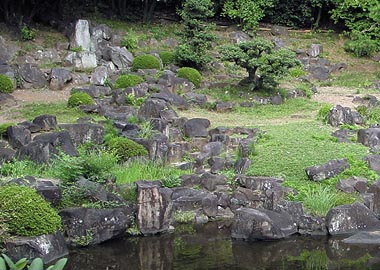|
||
 |
||

Toukouji
東光寺 (Yamanashi)
(C)2001 Japanese Architecture and Art Net Users System. No reproduction or republication without written permission.
掲載のテキスト・写真・イラストなど、全てのコンテンツの無断複製・転載を禁じます。
|
||||||
| karenagare 枯流 | ||||||
| KEY WORD : architecture / gardens | ||||||
| Lit.
dry stream. A common garden element construction in dry landscape *karesansui 枯山水. Typically it is created by making a stone revetment *karesansui gogan 枯山水護岸 and then raking pebbles or white sand into wave or ripple patterns; in a
few examples moss is also be used. Often a stone bridge spans the dry stream to
emphasize its symbolic function as a watercourse. Other stones symbolizing a treasure
ship takarabune 宝舟 or islands may be placed in the "stream" to further
its symbolic status as water. The karenagare usually begins at the base
of a dry waterfall *karetaki 枯滝, continuing the flow of water begun there. Outstanding examples include dry
streams in gardens at Saihouji 西芳寺 in Kyoto and Toukouji 東光寺 in Yamanashi prefecture,
from the Kamakura period, Taizouin 退蔵院 at Myoushinji 妙心寺 and Daisen-in 大仙院 at
Daitokuji 大徳寺 in Kyoto, from the Muromachi period, as well as those at the Senshuukaku
千秋閣 in Tokushima prefecture and Nanshuuji 南宗寺 in Osaka, from the Momoyama period. |
||||||
 Toukouji
東光寺 (Yamanashi)
|
||||||
| REFERENCES: | ||||||
| *nagare 流 | ||||||
| EXTERNAL LINKS: | ||||||
| NOTES: | ||||||
(C)2001 Japanese Architecture and Art Net Users System. No reproduction or republication without written permission. 掲載のテキスト・写真・イラストなど、全てのコンテンツの無断複製・転載を禁じます。 |
||||||